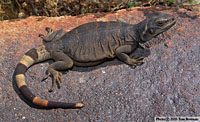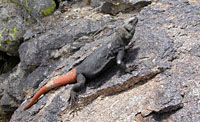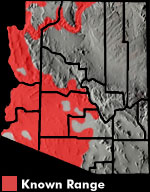Online Field Guide to The Reptiles and Amphibians of Arizona


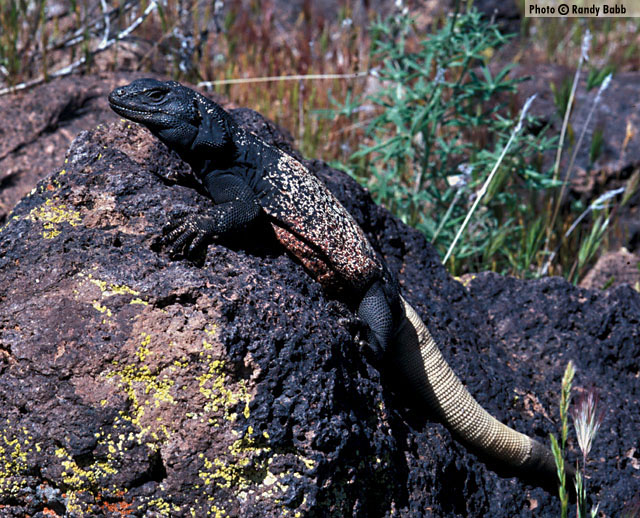
Maricopa County, AZ
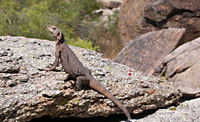 Female. Maricopa Co., AZ |
||
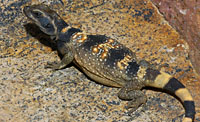 Juvenile. Maricopa Co., AZ |
| COMMON CHUCKWALLA Sauromalus ater | |
|
DESCRIPTION: A large (up to 229 mm or 9″ from snout to vent) flat and wide lizard with loose folds of skin on the neck and sides of the body. The head, shoulders, and limbs of males are black. Large males have pale gray to cream colored tails. Males on South Mountain in Phoenix have bright “carrot orange” tails. Across most of its range in Arizona large males have orange-red torsos. Large males from Glen Canyon in north central Arizona have pale ash gray torsos. Males from south-central Arizona (south of Phoenix) have black torsos. Females are gray-brown with faint mottling or crossbars and often have faint gray bands on the tail. In far northwestern Arizona adults of both sexes are banded. Young are pale gray with distinct black crossbands on the body and tail. The head is flattened and broad. The tail is blunt on the end and broad at the base. The small, granular body scales of this lizard distinguish it from the Gila Monster which has large bead-like scales. HABITAT: Most of this lizard’s range in Arizona is within the Sonoran and Mohave Desertscrub communities. Populations in the upper Grand Canyon and Glen Canyon are within Great Basin Desertscrub. In some areas it enters Interior Chaparral and Semidesert Grassland. This crevice-dweller is found in rocky habitats such as boulder fields, outcroppings on hillsides and slopes, and lava fields. BEHAVIOR: The Common Chuckwalla is a diurnal rock crevice-dweller. It is often seen basking on boulders, outcroppings, and rock piles. When threatened it retreats into a rock crevice and inflates itself with air until it becomes securely wedged. DIET: This lizard is primarily herbivorous. It feeds on a variety of annuals and some perennial plants. It also occasionally supplements its diet with insects. REPRODUCTION: Mating takes place in spring and a clutch of up to 16 eggs is laid in summer. The eggs are buried in a nest excavated from moist soil. By Thomas C. Brennan Brennan, T. C., & A. T. Holycross. 2006. A Field Guide to Amphibians and Reptiles in Arizona. Arizona Game and Fish Department. Phoenix, AZ Brennan, T. C., & A. T. Holycross. 2005. A Field Guide to Amphibians and Reptiles of Maricopa County. Arizona Game and Fish Department. Phoenix, AZ |
|
Visit Partners in Amphibian and Reptile Conservation:


HOME
Copyright © 2023, Arizona Game and Fish Department. All rights reserved.
If you make use of the textual contents of this site in reports, publications, etc. please cite and credit the author(s) and photographer(s). All photos on this website are copyrighted. However, those found in the species account section may be used for any noncommercial scientific, educational, or conservation purposes provided that photographs are not altered and continue to bear the copyright symbol and name of the photographer. Please contact the photographer regarding commercial use of copyrighted photographs.










